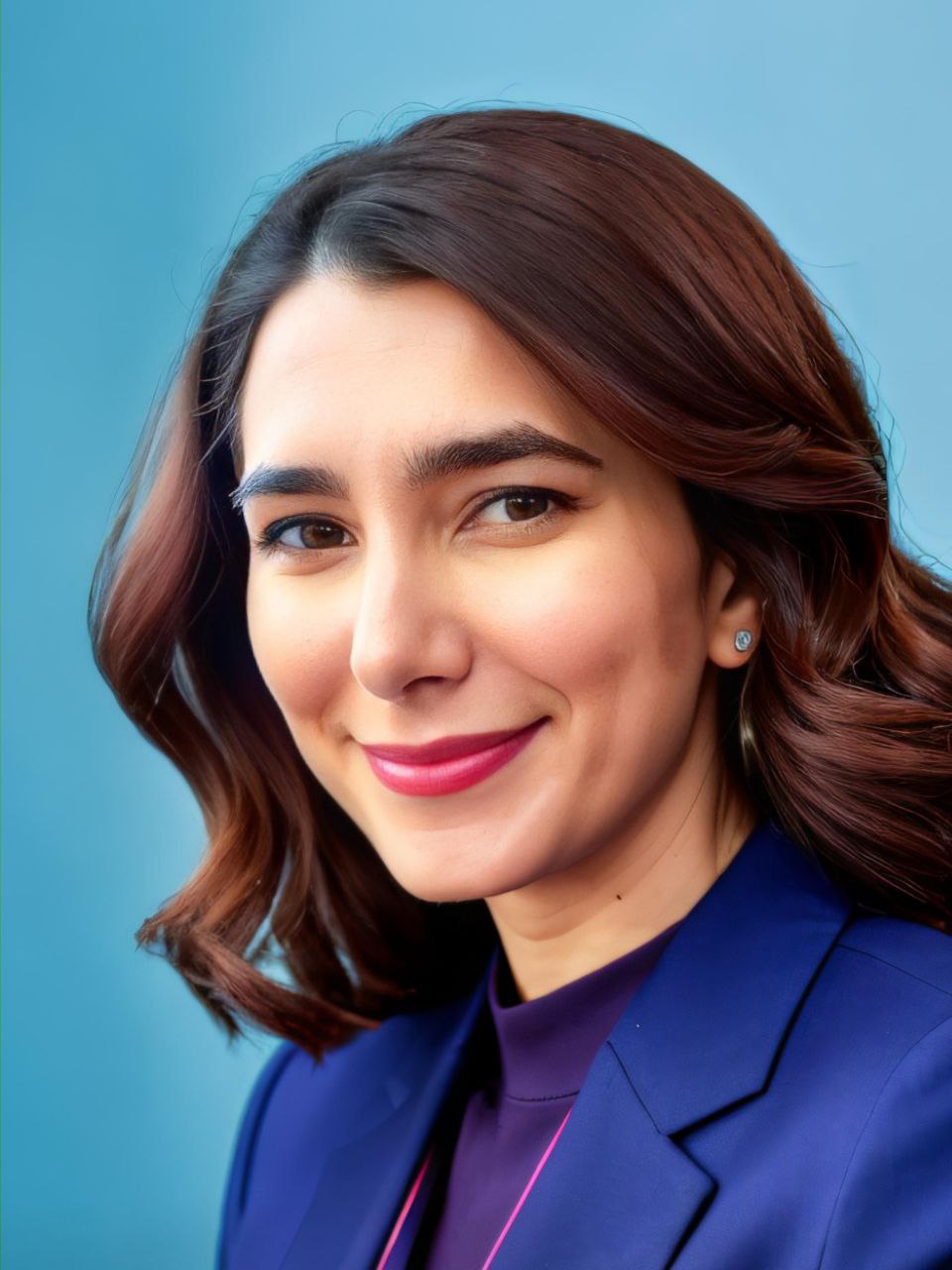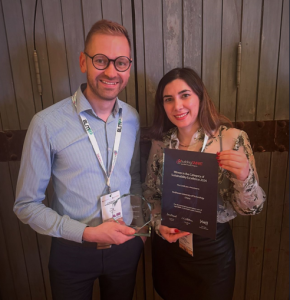This year, Researchers’ Days offered the perfect opportunity to reconnect with familiar faces. One such face is Arghavan, who spent over four years as a doctoral researcher at the University of Luxembourg, focusing on the circular transformation of built assets at the end of their life cycle. Her work, conducted within the framework of the Waldmann’s ECON4SD project, recently earned her a prestigious award. Let’s catch up with Arghavan to learn more about her journey and achievements since her time at our Faculty!
1. Arghavan, could you tell us a bit more about your background and how you got started in this field?
Hi, my name is Arghavan, and my background is in civil and environmental engineering, as well as business administration. I completed my PhD at the University of Luxembourg in 2023. I focused on information modelling for circular transformations of built assets at the end of their lifecycle.
My interest in buildings, architecture, and engineering began early on, but it was the concept of sustainable development that truly captured my attention. Understanding the multi-layer impact of our decisions on the environment and each other inspired me to explore the environmental aspects of buildings.
During my master’s studies, I was introduced to Building Information Modelling (BIM) and interoperability. It was a relatively new concept at the time, and I found it fascinating and challenging. Since then, BIM has been a central focus of my academic and professional journey.
2. Since your time at our Faculty, a lot has happened, including your recent win of the BuildingSMART openBIM Award. Can you tell us more about the project behind this success?
There are two main approaches to implementing openBIM. For my PhD, I focused on circular data modeling, especially for post-deconstruction and reuse, rather than trying to solve technological challenges at the same time. I initially worked on a Linked Data approach for a web-based material bank. By the end of my PhD, I became interested in the buildingSMART Data Dictionary (bSDD) as an alternative way of modeling data. This made my circular construction model more accessible for industry professionals.
I’m not sure what exactly made my project stand out in the buildingSMART Award 2024. It likely had to do with how well it aligns with circular economy standards and its compatibility with BIM and digital twin ISO/CEN standards. The project was inspired by existing standards, making it both current and future-proof. Additionally, the solution streamlines end-to-end processes for circularity, material banks, and reuse—critical needs in today’s construction industry.
One scientific challenge I addressed was moving beyond simple metrics like “76% reusable.” Instead, I focused on digitally describing how to achieve that level of reusability and identifying the specific steps required. This approach enables BIM to assess reusability, making it actionable rather than just presenting a static metric.
For example, in 2080, a deconstruction team wouldn’t just see that a component is “76% reusable”. They would get clear guidance on how to deconstruct, repair, or test it for reuse. This approach, I believe, offers a new way to model data for circular economy applications in construction.
‟ […] I’m glad because, as a critical person even of my own work, I can see that the solution is effective. It is openly accessible and provides a robust infrastructure for other digital projects to be more circular. ”

Postdoctoral researcher
3. How does it feel to have your work recognised in such a significant way?
On a personal level, it is an honour to receive such a prestigious award. It represents the culmination of many years of work during my PhD and partially the year after. Even the submission process was a considerable effort, requiring us to compile and present extensive details about the project. However, it turned out to be a valuable exercise. It allowed us to organise the project in a way that others could easily understand and encouraged us to reflect more critically on our work.
Beyond being an achievement for me personally, I’m glad because, as a critical person even of my own work, I can see that the solution is effective. It is openly accessible and provides a robust infrastructure for other digital projects to be more circular. This recognition is particularly meaningful because the project has been hudged judged and peer-reviewed, which validates its quality and impact.
4. Digital tools like openBIM are game-changers for the construction industry. How do you see their role in driving more sustainable practices in the sector?
The main benefit of openBIM is that it prevents data loss and ensures seamless information sharing across stakeholders and tools. This reduces errors, saves time, and cuts costs for everyone involved, from designers to building owners.
For sustainability, openBIM helps track key data, such as the reuse potential of building components, ensuring it stays accurate, up-to-date, and exchangeable. This is especially important for circular economy practices, where information might be needed decades later—like reusing a slab in 50 years. OpenBIM’s structured, machine-readable data ensures this information remains accessible and adaptable to future technologies, reducing the risk of obsolescence.
OpenBIM is also crucial for small and medium-sized enterprises (SMEs) in construction, who often can’t afford expensive BIM software licences. This tool enables these firms to adopt sustainable practices without the high costs. So it helps them to contribute to environmental goals while remaining competitive.
5. Share with us some of the biggest challenged you faced during your research. How did you overcome them?
During my research, I faced two main challenges. The first was related to the emerging nature of the circular economy as a topic. At the time, both the construction industry and academia had limited understanding of how to approach it. Our vision for a material bank and circular construction in the ECON4SD project, especially ideas like reusing structural elements in the future, was quite forward-thinking.
To address this, I often had to imagine what an architect or engineer in 2080 might need from a digital model. What information would be important? How could we present it in a way that was clear, concise, and useful to communicate about reusability? This required a lot of forward planning and design thinking.
One particular challenge I faced was managing the differing expectations of people from various backgrounds and experiences. Depending on their roles, each person had different views on what a material bank or circular economy-related information and terminology should entail. The overarching goal of the project was to “close the loop,” creating a shared terminology that could describe processes for exchanging materials and resources from one lifecycle to the next. This required taking into account a wide range of considerations, including different types of stakeholders, life cycle phases, and products. Balancing these diverse perspectives was incredibly complex. The taxonomy had to be broad enough to accommodate various needs while remaining precise and usable across disciplines.
The second challenge was figuring out how to model this information so that it aligned with best practices in data modeling. Due to the complexity and spatio-temporal requirements of circular terminology, this was another difficult task. In fact, this might be another reason why the project stood out, as you had asked earlier. I ensured that the data model captured all the essential details with minimal redundancy while remaining applicable across various lifecycle phases and for a wide range of stakeholders.
‟ BIM is not just about technology; it’s about aligning business processes to ensure tasks are completed correctly with the support of technology.”

Postdoctoral researcher
6. Looking ahead, how do you envision the future of BIM technology in the context of sustainability?
I often hear people talking about the desire for a “one-stop-shop” BIM solution. While this would be ideal, it’s currently more of an unrealistic goal due to both business challenges and technological limitations. Many experts agree that fully integrating all systems will take time. In the meantime, we have to find ways to bridge the gaps. Right now, industrial projects use a mix of tools and intermediary software to connect different systems. While this approach works to some extent, it often causes inconsistencies and data issues, particularly in emerging areas like the circular economy.
Sustainability is such a broad and evolving field that, no matter how much progress we make, new challenges will always arise. In five years, we might see better integration of end-of-life and circularity data into tools, but issues like biodiversity—an area still underexplored—could become more urgent. Sustainability will continue to evolve, and our digital solutions must keep up to address new demands.
One possible way forward is to establish regulatory guidelines with mandatory minimum information requirements. BIM is not just about technology. It’s about aligning business processes to ensure the correct completion of tasks with the support of technology. In the future, setting standardised (or at least minimum) information requirements for different projects or phases could provide a consistent foundation for addressing environmental issues, tailored to local or global needs.
Another promising direction is the shift from traditional BIM to Digital Twins. Unlike static BIM models, Digital Twins are linked to the physical world and updated in real-time through sensors or other tracking methods. This dynamic approach could be highly valuable for improving occupant comfort or tracking the life cycle of components.
7. Finally, do you have any exciting projects or plans on the horizon that you’re particularly looking forward to?
Yes! When I finished my PhD, I realised that even though the solutions I created are freely available and designed for day-to-day use, there’s still a noticeable hesitation to adopt them. Many people either don’t know how to use these solutions or don’t fully understand their importance. Sometimes, they are held back by fear of failure or resistance to change.
In my current research, I’ve been focusing on how we can onboard people more effectively. One of the approaches I’ve been exploring is using serious gaming to break down complex topics. This allows practitioners to explore these technologies in a safe, engaging environment. Over the past 16 months, I’ve been deeply involved in serious gaming, from foundational work and gathering industry insights to prototyping built environment serious games that meet practitioners’ needs. What I’m most excited about is that many of these results will be published in 2025.
